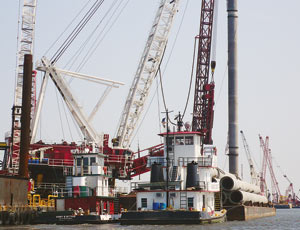The U.S. Army Corps of Engineers and contractors building a $695-million storm surge barrier in New Orleans are wrangling with the U.S. Coast Guard over an evacuation plan for heavy equipment that neither stymies construction nor risks damage to levees and floodwalls from storm-tossed vessels if a hurricane comes in. The Coast Guard is demanding the armada of floating equipment now at work on the Inner Harbor Navigation Canal Lake Borgne Storm Surge Barrier clear the area if a storm threatens. Typically, many tropical storms pass within a five-day run of the city during a hurricane season. This year, that would trigger an order to pull out the fleet.

The barrier is to be operational by June 2011. There are now about 25 cranes and 60 barges on-site, with more expected by summer’s end.
The Corps, prime contractor Shaw Environmental & Infrastructure Group, Baton Rouge, and its subs want to shelter the equipment nearby to shorten interruptions. However, to comply with the Coast Guard’s restrictions, some of the largest pieces now will have to pull out many days before a possible hit. Contractors worry the project could be seriously delayed because of the demand.
“The whole point is to protect the city, and I don’t think anyone wants us to shut down mid-July to mid-September because we might have a hurricane,” says Vic Zillmer, Corps resident engineer and project manager. “I don’t think anyone would find that acceptable.”
Loggerheads
The Coast Guard is seeking federal designation of a floodwall-rimmed area that includes the project site as a regulated navigation area, or RNA, that would include the sheltered anchorages contractors had planned to use—the Inner Harbor Navigation Canal and the Gulf Intracoastal Waterway from the IHNC to a point 22 miles to the east. The designation would ban commercial vessels within 24 hours of the predicted arrival of 34-knot gale-force winds, says Stephen Nutting, the Coast Guard’s New Orleans command center supervisor. Even without RNA designation, Nutting says the Coast Guard will order vessels out if a storm nears.
The Corps has a plan to evacuate much of the equipment and barges to Lake Pontchartrain. But the nine biggest cranes are too large to pass into the lake. The Corps thought it had an agreement to tie the big cranes down at the nearby Port of Bienville, but “that fell through because they were worried about damage to the port,” Zillmer says.
The subcontractor with the biggest pieces, TMW LLC, a joint venture of Traylor Bros. Inc., Evansville, Ind.; Massman Construction Co., St. Louis, and Weeks Marine, Cranford, N.J., has found a haven on the Pearl River, a 12-hour run, 25 miles east. But TMW and Shaw say demobilizing for the trip would have to start 10 days in advance of a hurricane.
“At 10 days out, you have no idea where the storm is. It might not even be in the Gulf,” says Charlie Hess, Shaw senior vice president of operations. “That would be a big interruption, and it might be a false interruption,” he says.
Shaw also would need to hire several 1,800-hp or greater push boats to make the move, and boat operators need seven to 10 days notice, Zillmer says.
Shaw wants to raft the big vessels together and moor them in the Michoud Canal or Michoud Slip, both of which lie within the prohibited area. “We want to put them in a place where we can spud down and ride out the storm in closer proximity,” Hess says. “Given the size of the equipment, we feel we can raft it together in one continuous unit and control how that whole operation would work.”
The Coast Guard is “in discussion with various partners in the maritime community,” Nutting says. But for now, “We do not intend to grant waivers, even for vessels that are moored on spuds or pilings,” he says. “Safety is our priority.”
Hess agrees there is some risk associated with the Shaw plan but contends there is risk in delaying the construction schedule and bearing the attendant costs. “We can take some risk in a process, but there is also risk if it takes 10 days to get out of Dodge,” Hess says. “You can’t plan a bid for that.”



Post a comment to this article
Report Abusive Comment